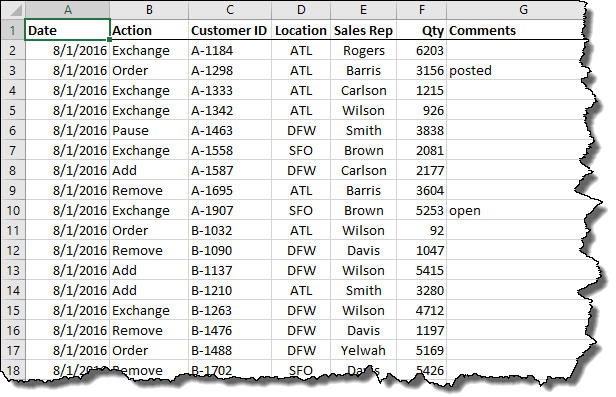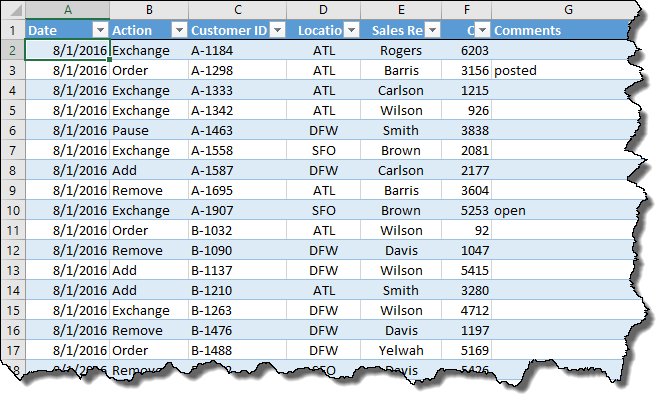What Is The Difference Between A Table And A Range In Excel? Select Four That Apply.
Differences between Tables and Named Ranges
David wonders what the difference is between tables and named ranges and why he would prefer one over the other. He currently uses ranges are named, of course, and they are dynamic when it suits his purposes (most of the time).
There is probably quite a bit near tables that could be written—probably much more what I'll choose to write here. The bottom line is that a named range can be very powerful in formulas. Still, a tabular array encompasses named ranges (they are utilized in how Excel defines tables) and adds quite a bit more functionality.
To understand what I hateful, allow'due south accept a wait at how you create a table. It is not uncommon to take data in Excel that is quite "tabular." Information technology consists of rows and columns, with the first row used to add column headings. (See Figure 1.)

Figure 1. Sample data in a worksheet.
You convert this data to a table by selecting whatever jail cell in the data and so clicking the Tabular array tool on the Insert tab of the ribbon. Excel asks you to confirm that you want to convert the information to a table, and when y'all click on OK the deed is done. (Meet Effigy 2.)

Figure 2. Sample information in a divers table.
You can tell it is now a table considering Excel formats the information differently than information technology was before. It is now "banded" using alternate rows of color, designed to make it easier to keep your identify as yous work with the data.
Note, as well, that at that place are filter arrows at the correct side of each cavalcade. This is something you cannot do with named ranges: filter the data equally an inherent function of the range. If you click a downwards-arrow adjacent to a cavalcade, you lot'll see different ways to sort and filter the information in the table based on the contents of that column.
You lot'll also notice that the ribbon has changed; there is at present a Design tab, which should be selected. At the left side of the ribbon, in the Properties group, y'all run across the name which Excel has assigned to your new table. It defaults to something similar "Table1" or "Table2," but you should modify the name to something more descriptive of the data in your table. This is, essentially, a named range that applies to the tabular array as a whole.
As you showtime to piece of work with the tabular array, you'll notice other differences, every bit well. Here's a few of them:
- Your column headings remain visible at all times every bit you scroll down the table.
- You lot can modify the colors used to format your tabular array. (Utilise the controls on the Design tab of the ribbon.)
- You lot can add rows at the bottom of the tabular array and they remain a part of the table. (This cannot be done with named ranges. Instead you must add new rows above the terminal row of the range.)
- When you add a new row to the lesser of the tabular array, whatever formulas in the row immediately above are copied, automatically, to the new row.
- PivotTables and charts based on the tabular array update automatically as you add information to the table.
Another neat feature is that yous can apply "shorthand" in your table formulas. So, instead of specifying jail cell references in a formula, you could do something like this:
=[@Qty]*1.25
The brackets indicate you are using the shorthand code, which consists of the @ sign followed by the name of the column defined in your header. This can make for much easier-to-read formulas in the table.
This should give you lot a quick thought of how defined tables differ in usage from named ranges. Like I said, there is much more than that could be written about the differences, simply the best way to find out is to first using tables for your information and run into how they fit into your bodily utilize of Excel.
There is one "gotcha" you need to be aware of, notwithstanding. If you use tables in a workbook, you cannot share that workbook with others. Excel requires tables to be converted to named ranges if you make up one's mind to share the workbook with others.
ExcelTips is your source for cost-effective Microsoft Excel grooming. This tip (13476) applies to Microsoft Excel 2007, 2010, 2013, and 2016.
Source: https://excelribbon.tips.net/T013476_Differences_between_Tables_and_Named_Ranges.html
Posted by: mcqueengreasse.blogspot.com


0 Response to "What Is The Difference Between A Table And A Range In Excel? Select Four That Apply."
Post a Comment